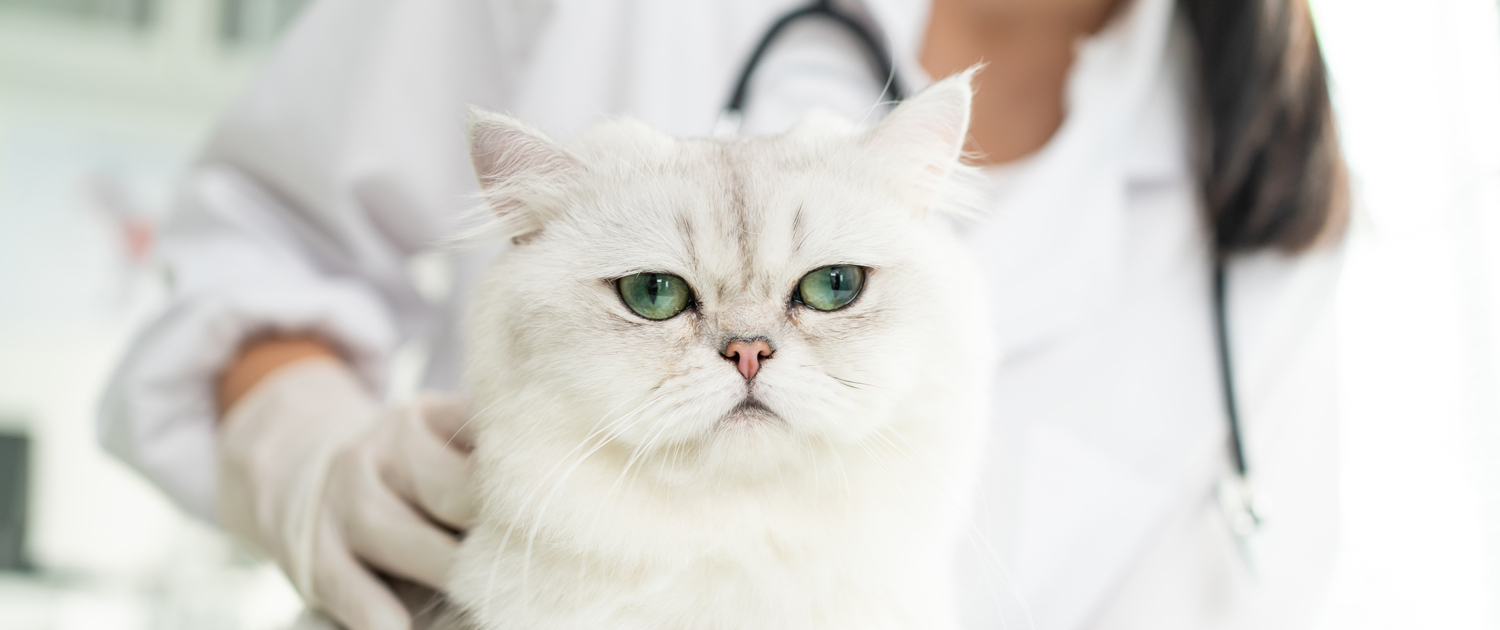Diagnosis
Treatment Options
Gland disorder
What is Feline Hyperthyroidism
The thyroid is a butterfly shaped gland in your cat’s neck just below the larynx (voice box). This gland is responsible for producing thyroid hormones T3 and T4, which are responsible for maintaining heart rate, breathing, intestinal movement, attitude, sweat glands and overall metabolism.
Feline hyperthyroidism is a disorder that occurs when the thyroid gland produces too much thyroid hormone. In most cases, about 97% to 98% in fact, the disease is caused by a benign tumor in the thyroid gland that is not responsive to the normal ‘on and off’ switches that control thyroid function.
Recognize and evaluate
Symptoms of Hyperthyroidism
- Weight loss
- Changes in behavior – anxiety or nervousness
- Excessive appetite or decreased appetite
- Increased water intake
- Hyperactivity or lethargy
- Excessive shedding, hair loss poor coat condition
- Diarrhea or vomiting
- Increased urination
- Cardiac symptoms – rapid heart rate, arrhythmia
Why is feline hyperthryroidism so common?
Hyperthyroidism in cats has increased markedly in the last 25 years. We really don’t know why. Genetics, immunologic factors, and environmental influences may all be involved.
What can I do as a pet owner?
The Cat Company understands this process may be difficult and complicated. Getting a diagnosis is the first step then looking at your treatment options. We are here to assist you and your veterinarian with these decisions.
Let’s find out.
Diagnosis
First, you and your vet should look for changes in your cat’s behavior. These might include any or all of the following:
- Weight loss
- Anxiety or nervousness
- Excessive appetite or decreased appetite
- Increased water intake
- Hyperactivity or lethargy
- Excessive shedding, hair loss poor coat condition
- Diarrhea or vomiting
- Increased urination
- Cardiac symptoms – rapid heart rate, arrhythmia
Normally the thyroid gland cannot be felt in your cat’s neck, but in some cases of hyperthyroidism, the gland becomes large enough to feel.
Since many of the signs of hyperthyroidism can also be found in other diseases such as diabetes mellitus, kidney failure, heart disease, or liver disease, laboratory tests such as a CBC, serum chemistry, and urinalysis are generally performed to determine if these diseases are present.
The total T4 or simply T4 is the best and most common test used to diagnose hyperthyroidism in your cat. Sometimes, veterinarians will use other tests to confirm their diagnosis of hyperthyroidism. These include the T3 suppression test, thyrotropin-releasing hormone stimulation test, measurement of free T4, and thyroid radionuclide uptake and imaging.
What are my options?
There are three approaches to treatment.
Definitive cure – no adverse side effects – Gold standard treatment.
Radioiodine I-131 Therapy
Radioiodine I-131 therapy. The great thing about I-131 is that it targets and destroys the abnormal thyroid tissue while attempting to spare the normal tissue that is not over-producing. It is safe for the cat, causes no adverse side effects, and has about a 95% success rate with one treatment. So, treating your cat with I-131 is actually pretty simple. The radioiodine does all the work.
20-25% of cats experience some type of adverse reaction.
Life-long medication methimazole
Life-long medication with methimazole. This medicine blocks thyroid hormone production but does nothing to stop the growth of the tumor. As it grows, the dosage of methimazole must continually change along with it. First used in human medicine as a short term therapy while patients waited for surgery or I-131 treatment, methimazole has numerous side-effects such as vomiting, loss of appetite, severe skin itch, liver damage, a drop in blood cell production and an increased susceptibility to infection. And if you’ve ever tried to give your cat a pill, you know how difficult this form of therapy can be over the long haul.
Anesthesia and post-surgical risks.
Surgical removal of the thyroid glands
Surgical removal of the thyroid glands. This treatment for hyperthyroidism has a long history. While there may still be a place for it in some cats, surgery in older stressed cats is not without risks. There may also be some diseased accessory thyroid tissue along the trachea in the chest, which will not be removed by standard thyroid surgery. Also, irritating the parathyroid glands can lead to a serious drop in blood calcium levels after the operation.
Care and Treatment of Feline Hyperthyroidism
The Cat Company
The Cat Company has been treating hyperthyroid cats using radioactive iodine for more than fifteen years. Throughout these years of experience, we have learned what cats and their loving owners truly need when treating this disease.
Make an Appointment
Speak with our caring professional staff and make a difference in the life of your cat.



